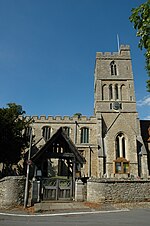Church of St Peter, Pavenham
Bedfordshire building and structure stubsChurch of England church buildings in BedfordshireEnglish church stubsGrade I listed churches in BedfordshirePavenham ... and 1 more
Use British English from February 2023

Church of St Peter is a Grade I listed church in Pavenham, Bedfordshire, England. It became a listed building on 13 July 1964.The church has some good examples of 14th-century canopied work. The carved panelling and rich woodwork is mainly of Jacobean date; it was installed in the 19th century by Thomas Abbot Green of Pavenham Bury.
Excerpt from the Wikipedia article Church of St Peter, Pavenham (License: CC BY-SA 3.0, Authors, Images).Church of St Peter, Pavenham
Church Lane,
Geographical coordinates (GPS) Address External links Nearby Places Show on map
Geographical coordinates (GPS)
| Latitude | Longitude |
|---|---|
| N 52.1929 ° | E -0.551 ° |
Address
St Peter
Church Lane
MK43 7PU
England, United Kingdom
Open on Google Maps





